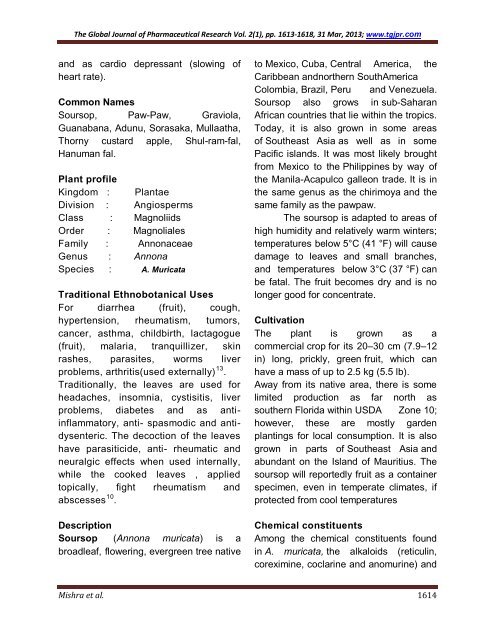Annona muricata (The cancer killer): A review
Annona muricata (The cancer killer): A review
Annona muricata (The cancer killer): A review
Create successful ePaper yourself
Turn your PDF publications into a flip-book with our unique Google optimized e-Paper software.
<strong>The</strong> Global Journal of Pharmaceutical Research Vol. 2(1), pp. 1613-1618, 31 Mar, 2013; www.tgjpr.com<br />
and as cardio depressant (slowing of<br />
heart rate).<br />
Common Names<br />
Soursop, Paw-Paw, Graviola,<br />
Guanabana, Adunu, Sorasaka, Mullaatha,<br />
Thorny custard apple, Shul-ram-fal,<br />
Hanuman fal.<br />
Plant profile<br />
Kingdom : Plantae<br />
Division : Angiosperms<br />
Class : Magnoliids<br />
Order : Magnoliales<br />
Family : <strong>Annona</strong>ceae<br />
Genus : <strong>Annona</strong><br />
Species : A. Muricata<br />
Traditional Ethnobotanical Uses<br />
For diarrhea (fruit), cough,<br />
hypertension, rheumatism, tumors,<br />
<strong>cancer</strong>, asthma, childbirth, lactagogue<br />
(fruit), malaria, tranquillizer, skin<br />
rashes, parasites, worms liver<br />
problems, arthritis(used externally) 13 .<br />
Traditionally, the leaves are used for<br />
headaches, insomnia, cystisitis, liver<br />
problems, diabetes and as anti-<br />
inflammatory, anti- spasmodic and anti-<br />
dysenteric. <strong>The</strong> decoction of the leaves<br />
have parasiticide, anti- rheumatic and<br />
neuralgic effects when used internally,<br />
while the cooked leaves , applied<br />
topically, fight rheumatism and<br />
abscesses 10 .<br />
Description<br />
Soursop (<strong>Annona</strong> <strong>muricata</strong>) is a<br />
broadleaf, flowering, evergreen tree native<br />
to Mexico, Cuba, Central America, the<br />
Caribbean andnorthern SouthAmerica<br />
Colombia, Brazil, Peru and Venezuela.<br />
Soursop also grows in sub-Saharan<br />
African countries that lie within the tropics.<br />
Today, it is also grown in some areas<br />
of Southeast Asia as well as in some<br />
Pacific islands. It was most likely brought<br />
from Mexico to the Philippines by way of<br />
the Manila-Acapulco galleon trade. It is in<br />
the same genus as the chirimoya and the<br />
same family as the pawpaw.<br />
<strong>The</strong> soursop is adapted to areas of<br />
high humidity and relatively warm winters;<br />
temperatures below 5°C (41 °F) will cause<br />
damage to leaves and small branches,<br />
and temperatures below 3°C (37 °F) can<br />
be fatal. <strong>The</strong> fruit becomes dry and is no<br />
longer good for concentrate.<br />
Cultivation<br />
<strong>The</strong> plant is grown as a<br />
commercial crop for its 20–30 cm (7.9–12<br />
in) long, prickly, green fruit, which can<br />
have a mass of up to 2.5 kg (5.5 lb).<br />
Away from its native area, there is some<br />
limited production as far north as<br />
southern Florida within USDA Zone 10;<br />
however, these are mostly garden<br />
plantings for local consumption. It is also<br />
grown in parts of Southeast Asia and<br />
abundant on the Island of Mauritius. <strong>The</strong><br />
soursop will reportedly fruit as a container<br />
specimen, even in temperate climates, if<br />
protected from cool temperatures<br />
Chemical constituents<br />
Among the chemical constituents found<br />
in A. <strong>muricata</strong>, the alkaloids (reticulin,<br />
coreximine, coclarine and anomurine) and<br />
Mishra et al. 1614


